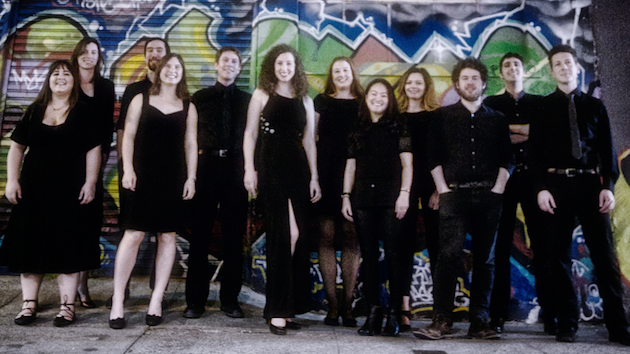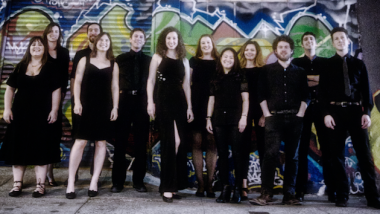
Had any of Berkeley’s stoners been at the Freight and Salvage Coffeehouse last Wednesday instead of going out to get high for 4/20 — the unofficial National Cannabis Day — they would have instantly recognized the G-minor chord that endlessly repeated over the venue’s speaker system that evening. It was the opening of Pink Floyd’s “Shine on You Crazy Diamond,” a nine-part rock “symphony” from the band’s 1975 album Wish You Were Here. However, the small audience wasn’t there to blaze it to Floyd, but rather to hear the new-music chamber group Wild Rumpus perform Fausto Romitelli’s 2003 video opera An Index of Metals.
An Index of Metals represents the apotheosis of Romitelli’s short-lived but prolific career; the Italian composer died tragically of cancer at the age of 41, a year after the opera’s premiere. His works are stylistically anchored in spectralism (using computers to analyze and manipulate physical properties of the sound spectrum), like his teachers Gérard Grisey and Hugues Dufourt. Yet Romitelli also added a personal touch to the timbral and acoustic experiments of spectralism by incorporating elements of psychedelic rock into his composition.
Hence the sample from Pink Floyd’s Wish You Were Here that opens An Index of Metals. Romitelli gives us only a short clip of the opening chord, which starts and stops as if someone were turning the record player on and off. In Wild Rumpus’ production, the repetition of this sample was playing even before the show began, as audience members purchased drinks at the auditorium’s bar.
Then, in a reversal of Haydn’s “Farewell” Symphony, each of the 13 members of the ensemble entered one-by-one in time to these iterations of G minor. The piece began with the instrumentalists adding new pitches to the G-minor chord, building up complex and shimmering spectral harmonies.
Above the ensemble were three screens — the “opera” portion of the work. Romitelli pushes that generic label to its limits; there is no plot, no scenery, no characters. The only singer, microphoned soprano Vanessa Langer, was more a member of the ensemble than a dramatis persona.
Anything vaguely reminiscent of operatic action took place in the tripartite film made especially for Romitelli by video artists Paolo Pachini and Leonardo Romoli. Many of the onscreen images appear to be the surfaces of everyday objects that, through extreme close-ups, are transformed into shifting psychedelic shapes and colors. Some of these serve as visual puns: Is that the surface of the ocean or merely sunlit asphalt? Is that a starry galaxy or a black, dust-covered surface? Are those tongues of fire or red reflections from inside a dented brass instrument?
Langer, in a disco-ball dress of silver sequins paired with big, Donna Summer hair, brought to vivid life texts by Croatian journalist Kenka Lèkovich. The poems, clearly inspired by the lyrics of 1960s psychedelic rock, were filled with metallic imagery. “Shining, growing / melting, drowning” sang Langer in her opening aria (or “Hallucination” as Lèkovich dubs the opera’s numbers) to a melody that was a near quotation of “See Me, Feel Me” from The Who’s Tommy. With her flexible and multihued voice, Langer skillfully interpreted Romitelli’s vocal part, which demands a vocalist who can embody both a Verdian dramatic soprano and a rock frontwoman along the lines of Janice Joplin or Grace Slick.
Connecting Langer’s “Hallucinations” numbers were instrumental interludes in which Romitelli experimented with sensory perception. The members of Wild Rumpus were able to merge their instrumental parts with surging electronic sounds so that at times it was impossible to differentiate between the acoustic and the digital. Not only did the ensemble have to sync with the electronic portions of Romitelli’s score (partly generated by Finnish Electronic group Pan Sonic) but also with the video triptych above their heads. In one terrifying passage, director Nathaniel Berman was able to perfectly line up the rate of a continuously descending melodic line in the ensemble with a portion of the video in which the camera rapidly panned down the gleaming windows of a skyscraper. While I hadn’t taken part in any of the drug-fueled 4/20 festivities that day, I clearly felt a hallucinatory sensation of falling to my death, waiting at any moment to hit the pavement.
At the end of the evening, Romitelli’s score, which constantly threatened to collapse into entropy, eventually disintegrated into a chaotic noise finale reminiscent of the Velvet Underground’s more experimental tracks. The ensemble suddenly cut off, leaving electric guitarist (and SFCV contributor) Giacomo Fiore to reiterate the opening repetitions of G minor. To video images of shattered glass and garbage rotating in a tumbler, he transitioned into an electrifying guitar solo, shredding like Jimi Hendrix or Jimmy Page. Speakers screeched with the sound of feedback as Fiore’s fingers danced over the frets. His psychedelic cadenza eventually spiraled into an out-of-control frenzy that disintegrated, leaving only the quiet buzzing of the sound system.
It took a minute or two of dead silence for the audience to emerge from this musical acid trip and greet the ensemble with well-deserved applause.

